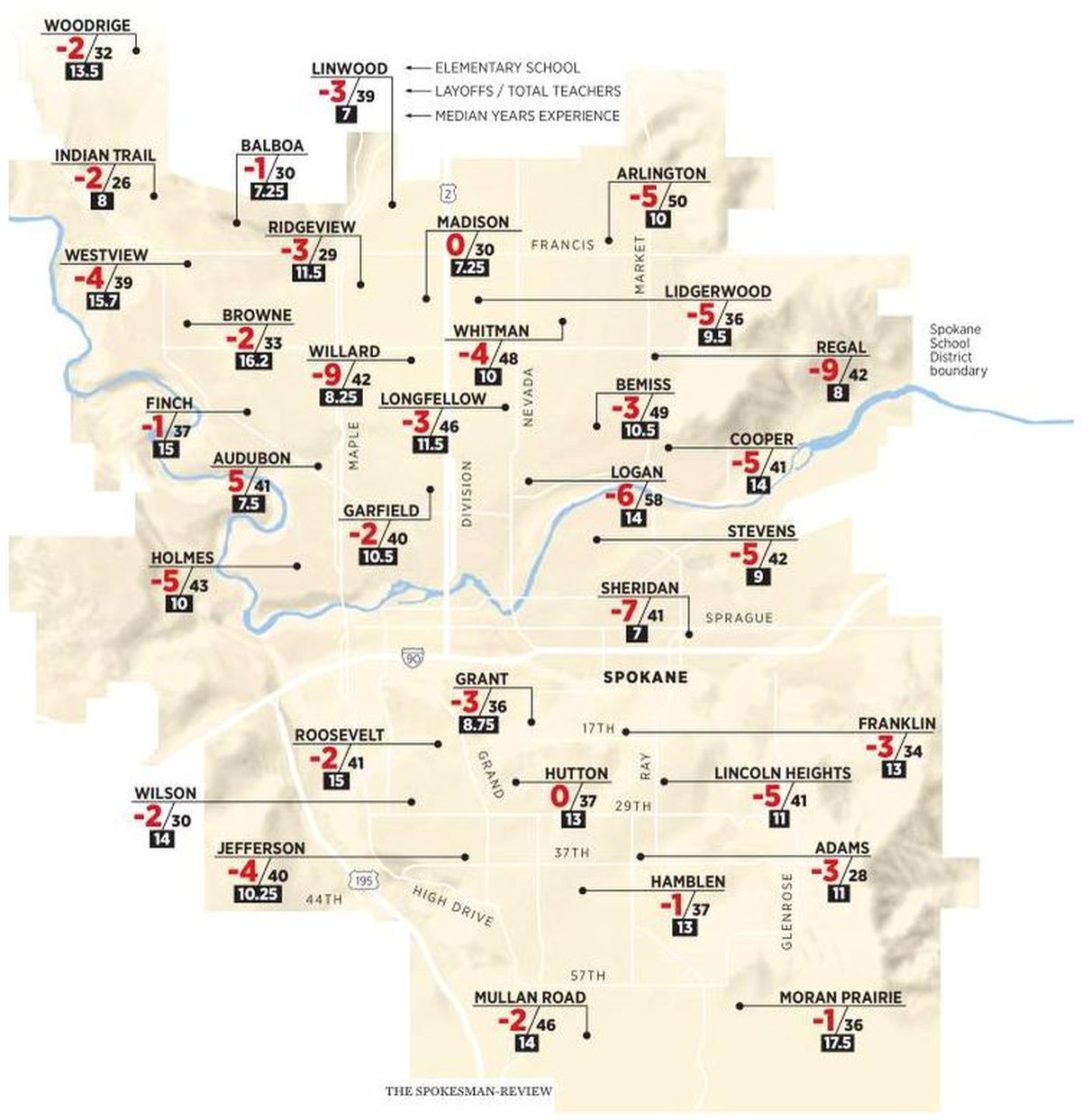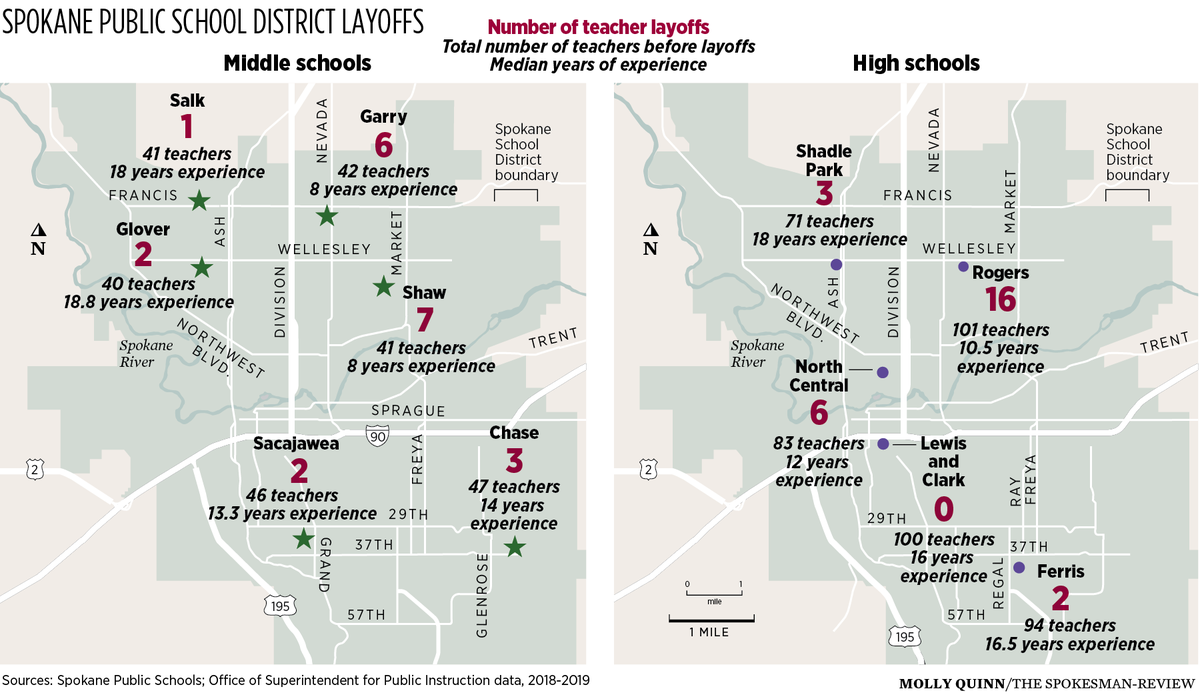Schools in low-income neighborhoods will shoulder most teacher layoffs
Regal Elementary School Principal Tricia Kannberg joins fourth-graders during mindfulness instruction, Friday, Feb. 22, 2019. (Dan Pelle / The Spokesman-Review)Buy a print of this photo
Life goes on, and so does learning.
That’s especially true at Regal Elementary School in northeast Spokane, where Principal Tricia Kannberg got the news last week that nine of her 42 teachers would lose their jobs because of the budget crisis at Spokane Public Schools.
That’s about 1 in 5, and Kannberg had to deliver the bad news to all nine – one-on-one.
Then she held a staff meeting that was as transformative as it was emotional.
“We talked about how difficult this is, and what I noticed is that the people who weren’t laid off, they really wanted to wrap their arms around those affected – and they did,” Kannberg said.
Those tough conversations happened last week at almost every school in the district, which is facing a $31 million budget deficit next year.
For the children’s sake, the staff had to move on.
“There’s 40 days left in the school year – that’s a lot of learning,” Kannberg said.
However, the cuts fell like a machete in Spokane’s low-income neighborhoods. Of the 183 certificated employees who received layoff notices last week, 74 work at 12 schools in northeast Spokane.
At every grade level next fall, they will soon feel the biggest impact of seniority-based teacher layoffs announced last week.
To fill some of those jobs, teachers with more seniority in schools not hit as hard will be reassigned to the schools hit hardest.
By next fall, Rogers High School will lose 16 teachers and counselors – more than the district’s four other comprehensive high schools combined – while Shaw Middle School loses seven and Garry Middle School loses six.
“I would say any time we’ve got to let our friends, our colleagues go, it’s always sad when that kind of thing happens,” said Jon Swett, the principal at Shaw.
Some of the hardest cuts came in the elementary schools in northeast Spokane.
Logan will lose six staffers, while Lidgerwood, Arlington, Cooper and Stevens will lose five each.
The average loss for all schools in northeast Spokane – those east of Division Street and north of Interstate 90 – works out to about 6.5 positions per building.
In contrast, the 15 schools located south of the freeway will lose a total 40 certificated staff, or fewer than three per school, according to data released by the district on Thursday following a public records request.
City Councilwoman Kate Burke, who represents the northeast section of town at City Hall, said she wasn’t surprised that layoff numbers appeared concentrated in the neighborhoods she represents.
“My constituents are already not doing as well as in other communities in the city,” Burke said Thursday. “It becomes a struggle for them to stand up for themselves. We need better services and we need more money.”
At Regal, where 90% of children receive free or reduced-price meals, the student-to-staff ratio is 13.5-to-1 – one of the lowest in the district.
In contrast, Hutton Elementary on the South Hill, has the highest student-to-staff ratio in Spokane at about 20-to-1.
However, Hutton is rated as the top elementary school in the district by some surveys. Perhaps for that reason, it has attracted a veteran staff. No teachers at Hutton received layoff notices last week.
Kannberg refuses to play the victim.
“We can’t get stuck in that,” Kannberg said. “Yes, there are challenges, but those are everywhere. We don’t dwell on that, and we don’t want kids using those things as an excuse.”
Many schools in more affluent neighborhoods were lightly touched by the layoffs. In downtown, Lewis and Clark was unaffected. On the South Hill, Ferris lost two staffers.
South Hill middle school Sacajawea lost two, and Chase lost three.
The 12 elementary schools on the South Hill lost 33 certificated staff, though a dozen came from Sheridan and Lincoln Heights.
The cuts happened concurrently with the district’s decision to eliminate all school librarians and move most of them to the classroom. Some studies indicate the loss of school libraries will affect low-income students disproportionately.
The numbers are no surprise to education experts, who note that many experienced teachers migrate to schools in higher-income areas.
According to a 2015 report by the Learning Policy Institute, national turnover rates are about 50% higher in schools that serve a greater proportion of low-income students.
It’s the same story in schools in northeast Spokane, where young teachers gain experience and then transfer to another job.
According to data from the Office of the State Superintendent, the range of teacher experience varies widely within the district.
At the top end, the median experience of teachers at Glover Middle School in northwest Spokane is 18.75 years.
At eight other schools – Shadle Park, Ferris and Lewis and Clark high schools, Salk Middle School and Moran Prairie, Browne, Westview and Roosevelt elementary schools – the median experience is 15 years.
At the bottom, 14 schools have teachers with a median of 10 years experience or less.
The news isn’t all bad for schools in lower-income neighborhoods. Some of the feeder schools in northeast Spokane did as well as their South Hill counterparts. Longfellow and Bemiss elementary schools, for example, will lose only three each, while in northwest Spokane, 10 of the 13 elementary schools lost three or fewer.
However, the numbers generally conform to demographics, which in turn compel some teachers to leave for better conditions.
Despite the disappointment and those demographics, life for students inside the walls at Regal and outside in the neighborhood is pretty good.
“I understand the problems, but good things are happening in this neighborhood,” Kannberg said. “The reality is that a lot of good work is going on in this community.”
Staff writer Kip Hill contributed to this report.


